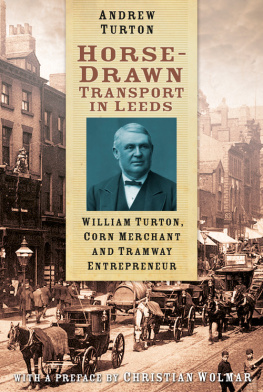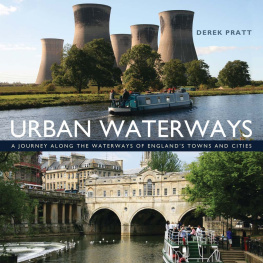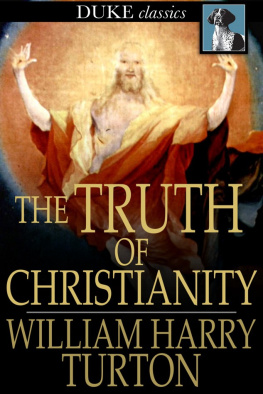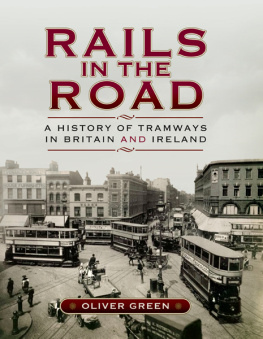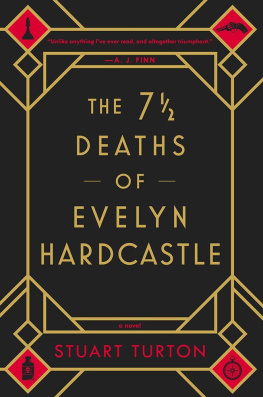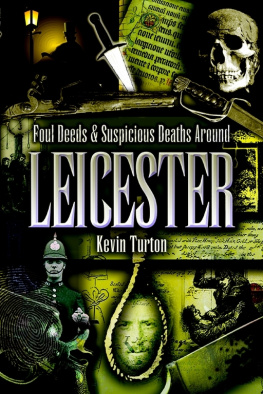

William Turton
2 January 1825 7 August 1900
to my paternal grandparents
Felicia Turton ( ne Roberts) 18781972
William Turton 18801965

In association with Leeds Philosophical & Literary Society
So many people gave me advice, information and encouragement. I wish to thank them all, including those whose names do not appear here.
A very special thanks is due to two of Leeds foremost historians. First to Jim Soper, Dipl. Arch., Dipl. TP, ARIBA, author of the fine five-volume Leeds Transport 18301986 and a founder member of the Leeds Transport Historical Society. My appreciation of his work and subsequent help is shown throughout the text.
Secondly, Dr David Thornton MPhil.; PhD. Author of some of the best books on Leeds and editor and council member of the Thoresby Society. He was the first person to read the text in draft form.
Other Leeds historians and writers: Raymond Dalton, Robin Dove, Kevin Grady and other members of the Leeds Civic Trust, Peter Hirschman, Martin Wainwright and Penny Wainwright.
The many people of Leeds who talked to me about Chapeltown, Hayfield House and other places and introduced me to people: Robin Corner, Pat Falkingham, Garth Frankland, Tiny Maguire, Graham Pawley, Jenny Samuel, Patricia Turner, Dave Walter.
Those who replied to my letter in The Yorkshire Post : John Barton, Harold Jackson and John Steele.
Those most hard-working librarians and archivists, and their staff, at the Leeds Family and Local History Library and Leeds Central Library; West Yorkshire Archive Service, Sheepscar (Stefanie Davidson) and Wakefield (Katie Proctor); LEODIS, Leeds Photographic Archive (Rose Gibson); The Leeds Library; The Thoresby Society (Greta and Peter Meredith); and, in London, the British Library in Euston Road, the Colindale newspaper library and the National Archives at Kew.
For help with the history of the Turton family: my paternal first cousins Norman William Turton, Peter John Turton and Philip Robin Turton who were in touch throughout; descendants of John Turton, my paternal second cousins twice removed the late Lance Turton, Elizabeth ( ne Turton) and David Toulmin, Ann Agar (ne Turton), Kitty Turton, David Turton, Ken Turton; Martin Stubbs, Michael Carter-Inman; also members of the Turton diaspora in Australia, Canada, New Zealand and South Africa Dorothy Turton Bjarnson, Vanessa Blake, Neal Hargreaves, Sharon Livingstone, Tony Turton, Emma Weeding, Kathy Westlake and others.
I owe a special debt of gratitude to the Leeds Philosophical and Literary Society, and its president Antony North and secretary Chris Hatton, for their sponsorship of my research and publication through two grants totalling 1,400.
I am honoured that Christian Wolmar accepted the task of writing a preface.
Amy Rigg, Editor at The History Press, for her professional advice.
To my friends Victoria Glendinning and Roger Jellinek, and my immediate family: my sister Ruth Christodolo, my daughters Clio Turton and Polly Turton, and my wife Antonia Benedek.
Andrew George William Turton, 2015
CONTENTS
I acknowledge with thanks the following sources of pictures and copyright permission. Other illustrations are out of copyright or deemed to be out of copyright. Please direct any enquiry about copyright to the author c/o the publisher.
Adam Gordon
Getty
Leeds Art Gallery
Leeds Civic Trust
Leeds Historical Transport Society
Leicester Library
Leodis (Leeds Library Services)
London School of Economics and Political Science
Thoresby Society
West Yorkshire Archives (Sheepscar)
Yorkshire Post
The author is responsible for the tables
Andrew Turton started out to research the life and business of his great-great-grandfather. This would have been an interesting subject in itself, if limited. But what he has produced is far more valuable. By putting the succession of businesses that developed as technology changed and his various ancestors developed new skills, he has created a book that explains and puts into context the development of horse-drawn transport in the nineteenth century.
The detail is fascinating. In my book The Subterranean Railway , the history of the London Underground, I explained how omnibus transport was costly to provide and as a result limited in scope. Mr Turton has put this into context in Leeds where the issues were similar. The need to run a transport business with horses was both expensive and risky, as well as creating vast amounts of waste material which, while useful as a fertiliser, earned little money because of its abundance.
Mr Turton points out that the age of the urban horse-drawn transport systems lasted just over three quarters of a century. Intercity transport by stagecoach was killed off by the railways. However, horse-drawn trams survived until the technology of electricity improved to such an extent that four-legged power became uneconomic.
Before getting on to the main focus of his history, Mr Turton takes us through the corn and hay and the coal and mining businesses of the nineteenth century. In the latter he shows some truly shocking statistics on deaths of miners and pit boys, many of whom were aged under 10 and even as young as 5. The fact that this happened just a few generations ago makes the history even more compelling.
The history of systems such as railways or tramways is a series of incidents and inventions which led to a particular technological path. The railways, for example, may never have happened had it not been for the poor condition of roads and the non-existence of rubber tyres in the early nineteenth century. Mr Turton does a good job of giving the back-story to the various reasons why tramways became such a popular and successful invention, albeit for a relatively brief period. Government involvement and regulation and often lack of it is always a key factor in these accounts. And, as all my own rail history books show, politics is never far from being one of the determining factors in the success or failure of various enterprises, which is why it is so relevant that one of this books sections is called Society and Politics. So the local authorities figure large, and, of course, the Leeds Town Hall gets a suitable mention. William Turton himself, like many entrepreneurs involved in transport in the nineteenth century, was involved in local politics.
Mr Turton livens up his in-depth historical account with numerous amusing anecdotes, such as the notice which informed Passengers desiring to sleep should instruct the conductor at what time they are to be awakened not a service offered on the late night buses and trains of today.
The strength of this book is that Mr Turton has managed to provide a tremendous amount of detail alongside salient interpretations of the facts. By putting these facts into a wider context he has created a fascinating read. Mr Turton has managed to write a transport history book, focusing on his own family, that provides an illuminating and compelling account of an important aspect of Victorian Britain.
Christian Wolmar, Transport historian
Trams have a promising future. They are being revived in many European towns and cities. In some they were never out of use; in others they have been rediscovered after a regrettable absence since the 1950s. Even horse trams might be part of this future. They were a key stage in the early development of urban passenger transport. Slow, green and sustainable, they should be remembered in contemporary debates about urban transport.
Next page
